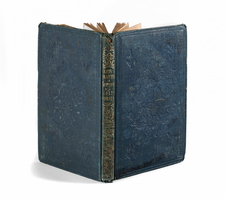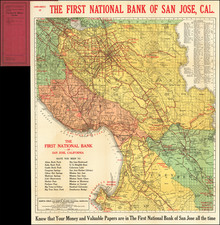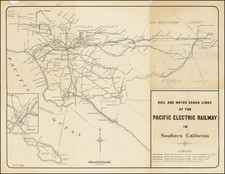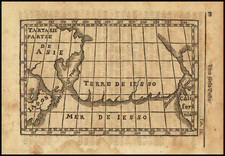Detailed map of the Los Angeles Basin, extending from the Santa Monica Mountains to Newport Beach and east to Lake Elsinore, San Jacinto, Redlands and Yucaipa.
A color coded key identifies the rail lines depicted:
- Pacific Electric Ry (red)
- Los Angeles Pacific Ry (orange)
- Crescent City Ry (pink)
- Southern Pacific RR (light purple)
- Santa Fe Ry (green)
- Salt Lake RR (blue)
- Glendale & Eagle Rock Ry: (magenta)
This remakable large format map provides a remarkable snapshot of the development of Urban Transit in the Los Angeles Basin.
Electric trolleys first traveled in Los Angeles in 1887. In 1895, The Pasadena and Pacific Railway was created from a merger of the Pasadena and Los Angeles Railway and the Los Angeles Pacific Railway (to Santa Monica). The Pasadena and Pacific Railway boosted Southern California tourism, living up to its motto "from the mountains to the sea."
The Pacific Electric Railroad was created in 1901 by railroad executive Henry Huntington and banker Isaias W. Hellman. As a Vice-President of the Southern Pacific Railroad, Henry Huntington had a solid background in electric trolley lines in San Francisco where he oversaw the SP's effort to consolidate many smaller street railroads into one organized network. Hellman, the President of the Nevada Bank, became one of the largest bond holders for these lines and he and the younger Huntington developed a close business relationship. The success of their San Francisco trolley adventure and Hellman's experience in financing some early Los Angeles trolley lines, led them to invest in the purchase of some existing downtown Los Angeles lines which they began to standardize and organize into one network, called under the Los Angeles Railway.
In May 1901 Hellman, who had been Southern California's leading banker for almost three decades (and had much property down there), wrote Huntington that "the time is at hand when we should commence building suburban railroads out of the city." In 1901, Huntington and Hellman incorporated a new entity, the Pacific Electric Railroad, to construct these new electric rail lines to connect Los Angeles with surrounding cities. The syndicate began purchasing property and rights-of-ways. The new company's first main project, the line to Long Beach, opened for business in July 1902.
Huntington experienced a variety of opposition from organized labor efforts beginning with the construction of the new railways. Tensions between union leaders and other like minded Los Angeles business men were kept high from the early 1900s up through the 1920s. Strikes and boycotts troubled Pacific Electric throughout those years, until it reached a height of violence in the 1919 Streetcar Strike of Los Angeles.
Railroads were only one part of the enterprise. Revenue from passenger traffic was rarely enough to turn much, if any, profit. Freight traffic usually was profitable. The real money for the investors was in the supplying electric power to these new communities and in real estate. To get railroads and electricity to their towns, local groups would offer the Huntington interests opportunities in local land. Soon Huntington and his partners had significant holdings in the land companies developing Naples, Bay City (Seal Beach), Huntington Beach, Newport Beach and Redondo Beach.
By 1903, Huntington's insistence on reinvesting profits into costly expansion rather than paying any stockholder dividends, caused the Hellman group to offer a great part of their stock to E.H. Harriman, making him and Huntington equal partners. After an overnight trip to San Francisco, an arrangement was worked out between Harriman and Huntington. Huntington could expand the PE as he saw fit, but he was not to compete with existing SP lines.
Huntington continued to expand his railroad and not declare profits. After Huntington's purchase of the Redondo Railroad in 1905, the Hellman group sold the rest of their shares to Harriman, leaving the PE in effective control of Harriman and the Southern Pacific. Harriman continued to leave Huntington alone until 1910 when the SP refused to allow the Pacific Electric to run a line to San Diego, that would compete with the SP's existing line.
On March 19, 1906, an agreement was reached to sell all the Los Angeles Pacific Railroad lines, owned by Moses Sherman, for $6 million to the Pacific Electric Railway, this turned over all the lines in Pasadena, San Fernando Valley and West LA, to PE.
At this point, Huntington sold out all his PE stock to Harriman and in what was called the "Great Merger" of 1911, the SP and PE basically became one single operation, with all electrical operations now under the Pacific Electric name. Huntington retained control of the Los Angeles Railway.
Following these acquisitions, PE was the largest operator of interurban electric railway passenger service in the world, with 2,160 daily trains over 1,000 miles (1,600 km) of track. It ran to destinations all over Southern California, particularly to the south and east.
Large profits from land development were generated along the routes of the new lines. Huntington Beach was incorporated in 1909 and developed by the Huntington Beach Company, a real-estate development firm owned by Henry Huntington, which still owns both land in the city and most of the mineral rights.
There are other local 'streetcar suburbs'. Angelino Heights was built around the Temple Street horsecar, which was later upgraded to electric streetcar as part of the Yellow Car system. Highland Park was developed along the Figueroa Street trolley lines and railroads linking downtown Los Angeles and Pasadena. Huntington owned nearly all the stock in the 'Pacific Electric Land Company'. West Hollywood was established by Moses Sherman and his partners of the Los Angeles and Pacific Railway. Moses Sherman, Harry Chandler, Hobart Johnstone Whitley, and others bought the entire southern San Fernando Valley in 1910. The electric railway and a "$500,000" boulevard called Sherman Way connected the three townsites they were selling. These included Van Nuys, Marion (now Reseda), and Owensmouth (now Canoga Park). Parts of Sherman Way are now called Chandler Boulevard and Van Nuys Boulevard.











![[Eastern San Diego County] Cuyamaca Quadrangle](https://storage.googleapis.com/raremaps/img/small/83422.jpg)


